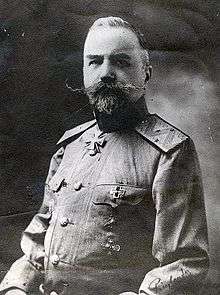Yevgeny Miller
Eugen Ludwig Müller (Russian: Евге́ний-Лю́двиг Ка́рлович Ми́ллер[1], tr. Evgeniy-Lyudvig Karlovich Miller; 25 September 1867 – 11 May 1939), better known as Yevgeny Miller, was a Baltic German general and one of the leaders of the anticommunist White Army during and after the Russian Civil War (1917–1922). After the civil war he lived in exile in France. Kidnapped by the Soviet intelligence operatives in Paris in 1937, he was smuggled to Moscow, the USSR, and executed there in 1939.
Yevgeny Miller | |
|---|---|
 General Yevgeny Miller | |
| Birth name | Eugen Ludwig Müller |
| Born | 25 September 1867 Dünaburg, Vitebsk Governorate, Russian Empire |
| Died | 11 May 1939 (aged 71) Moscow, Soviet Union |
| Allegiance | |
| Service/ | Imperial Russian Army White Army |
| Years of service | 1884–1920 |
| Rank | Lieutenant-General |
| Battles/wars | World War I Russian Civil War |
Early life
Miller was a career officer born to a Baltic German noble family in Dünaburg (now Daugavpils, Latvia).[2] After he graduated from the General Staff Academy, he served with the Russian Imperial Guard. Between 1898 and 1907, he was a Russian military attaché in several European capitals, such as Rome, The Hague and Brussels. During the First World War, he headed the Moscow Military District and the 26th Army Corps and was promoted to the rank of lieutenant general.
Civil War
After the February Revolution of 1917, Miller opposed "democratization" of the Russian army and was arrested by his own soldiers after he ordered them to remove red armbands.
After the October Revolution of 1917, Miller fled to Archangelsk and declared himself Governor-General of Northern Russia. In May 1919, Admiral Kolchak appointed him to replace Vladimir Marouchevsky in charge of the White Army in the region. In Archangelsk, Murmansk and Olonets, his anti-Bolshevik Northern Army was supported by the Triple Entente, mostly British forces. However, after an unsuccessful advance against the Red Army along the Northern Dvina in the summer of 1919, British forces withdrew from the region, and Miller's men faced the enemy alone.
Exile

In February 1920, General Miller with 800 refugees sailed from Archangelsk to Tromsø, Norway. Later, he moved to France and, together with Grand Duke Nicholas and Pyotr Nikolayevich Wrangel, continued his anticommunist activism.
Between 1930 and 1937, Miller served as chairman of the Russian All-Military Union, an organization of exiled former White Army officers and soldiers opposed to the Soviet Union. His niece Nathalie Sergueiew also fled to France and subsequently became an MI5 agent.[3] As the ROVS chairman, Miller was not an influential figure, as he did not belong to the dominant clan in the ROVS, namely former members of the White Army of South Russia, nor the former ″Gallipoli campers″.[4]
Illegal rendition
On 22 September 1937, NKVD agent and All-Military Union counter-intelligence chief Nikolai Skoblin led Miller to a Paris safe house, ostensibly to meet with two German Abwehr agents, who were in fact officers of the Soviet NKVD disguised as Germans. They drugged Miller, placed him in a steamer trunk and smuggled him aboard a Soviet ship in Le Havre.[5][6]
Miller had left behind a note to be opened in case he failed to return from the meeting. In it, he detailed his suspicions about Skoblin. French police launched a massive manhunt, but Skoblin fled to the Soviet embassy in Paris and eventually was smuggled to Barcelona, where the Second Spanish Republic refused to extradite him to France.[7]
However, the French authorities arrested Skoblin's wife, Nadezhda Plevitskaya, and a French court convicted her and sentenced her to 20 years in prison.[7][8]
The NKVD successfully smuggled Miller back to Moscow, where he was tortured and summarily shot nineteen months later on 11 May 1939. According to NKVD General Pavel Sudoplatov, "His kidnapping was a cause célèbre. Eliminating him disrupted his organization of Tsarist officers and effectively prevented them from collaborating with the Germans against us."[9] Sudoplatov also notes that Western accounts of NKVD officer Leonid Eitingon having played a role in the abduction of Miller are false.[10]
Copies of letters written by Miller while imprisoned in Moscow are in the Dmitri Volkogonov papers at the Library of Congress.
See also
- List of people who disappeared
- Mikhail Kvetsinsky, Miller's chief of staff
- North Russia Intervention
- Russian All-Military Union
- White movement
Notes and citations
- A. Tarulis, American-Baltic relations, 1918-1922: the struggle over recognition, Catholic University of America Press, 1965, p. 190
- V. Goldin, J. Long, Resistance and Retribution: The Life and Fate of General EK Miller. Revolutionary Russia, 1999.
- Собачье сердце и двойной обман
- ″Врангелов неоспорни ауторитет: Из тајних архива УДБЕ: РУСКА ЕМИГРАЦИЈА У ЈУГОСЛАВИЈИ 1918–1941.″ // Politika, 8 December 2017, p. 17.
- Sudoplatov 1994, pp. 38, 91.
- ″Помирљивост према политичким партијама: Из тајних архива УДБЕ: РУСКА ЕМИГРАЦИЈА У ЈУГОСЛАВИЈИ 1918–1941.″ // Politika, 12 December 2017, p. 21.
- Barmine, Alexander, One Who Survived, New York: G.P. Putnam (1945), pp. 232–233
- Orlov, Alexander, The March of Time, St. Ermin's Press (2004), ISBN 1-903608-05-8
- Sudoplatov 1994, p. 37.
- Sudoplatov 1994, p. 36.
References
| Wikimedia Commons has media related to Evgeny Miller. |
Books
- Sudoplatov, Pavel (1994). Special Tasks: The Memoirs of an Unwanted Witness — A Soviet Spymaster. Boston, MA: Little, Brown & Co. ISBN 0316773522.CS1 maint: ref=harv (link)
- Barmine, Alexander, One Who Survived, New York: G.P. Putnam's Sons (1945)
- Orlov, Alexander, The March of Time, St. Ermin's Press (2004), ISBN 1-903608-05-8
- Quinlivian, Peter (2006). Forgotten Valour: The Story of Arthur Sullivan VC. Sydney: New Holland. ISBN 978-1-74110-486-8.